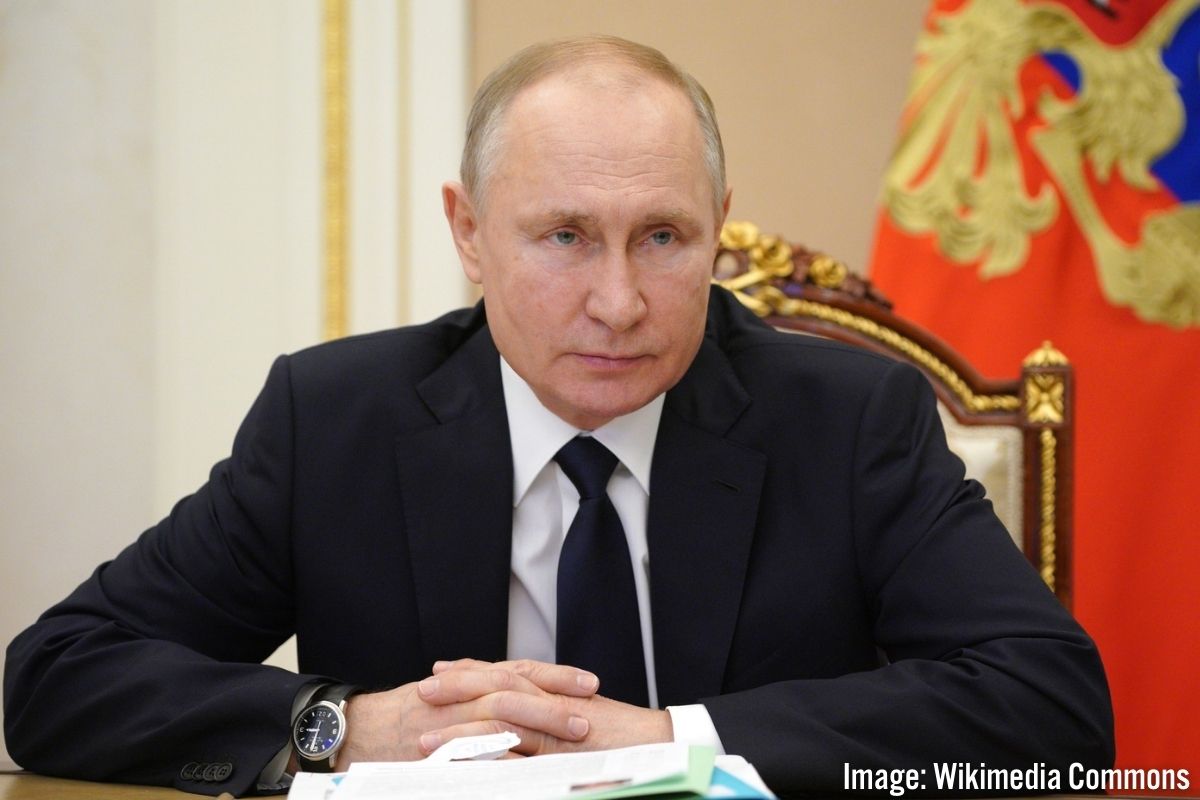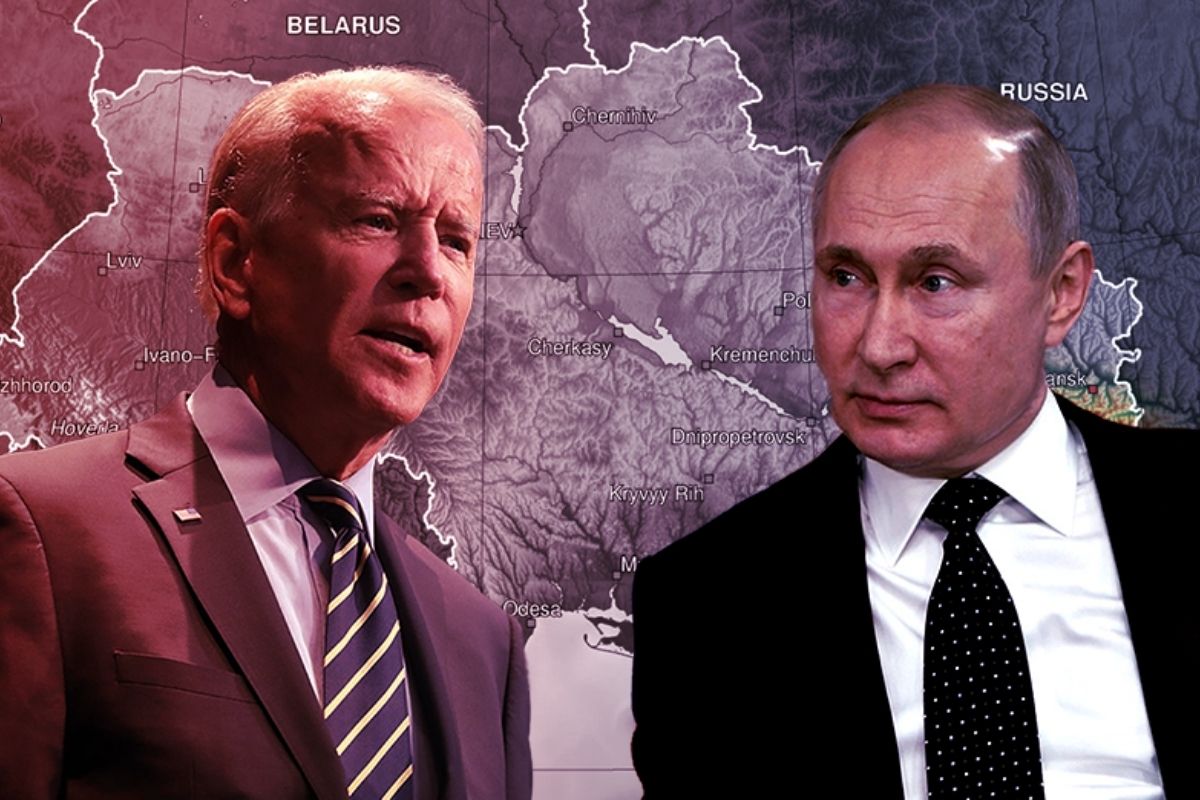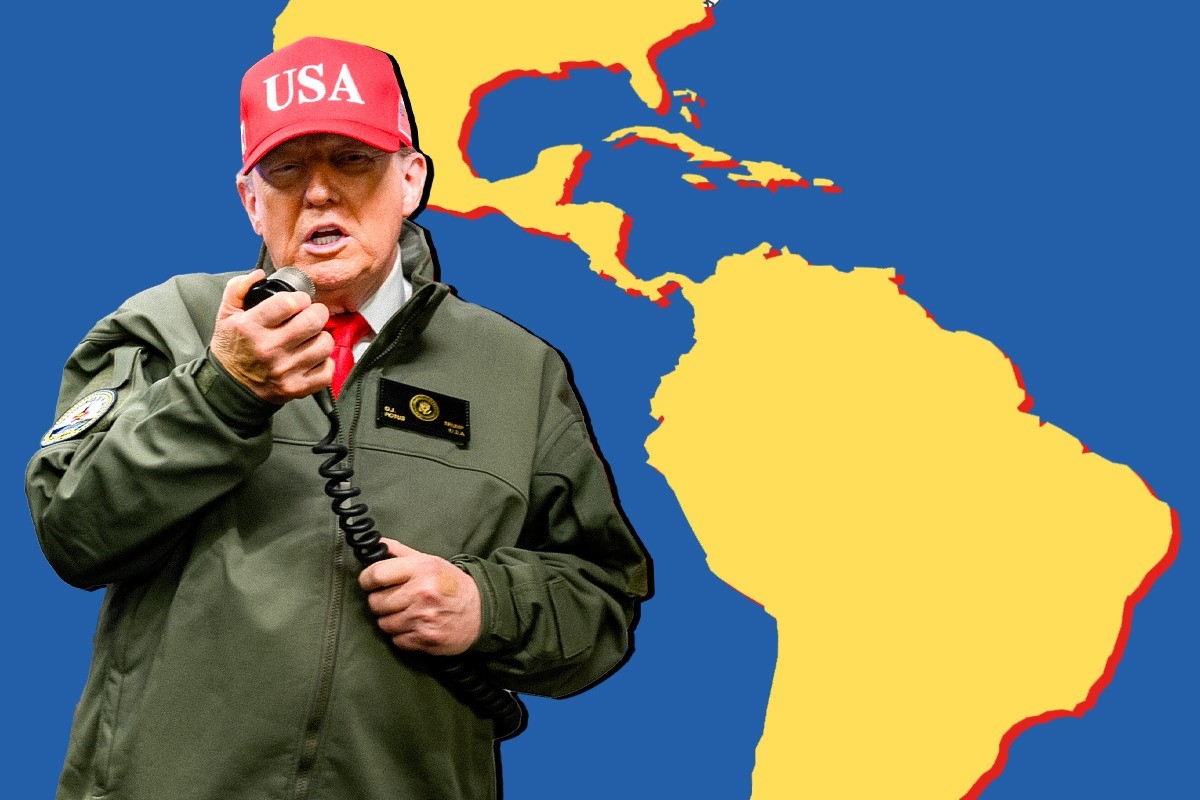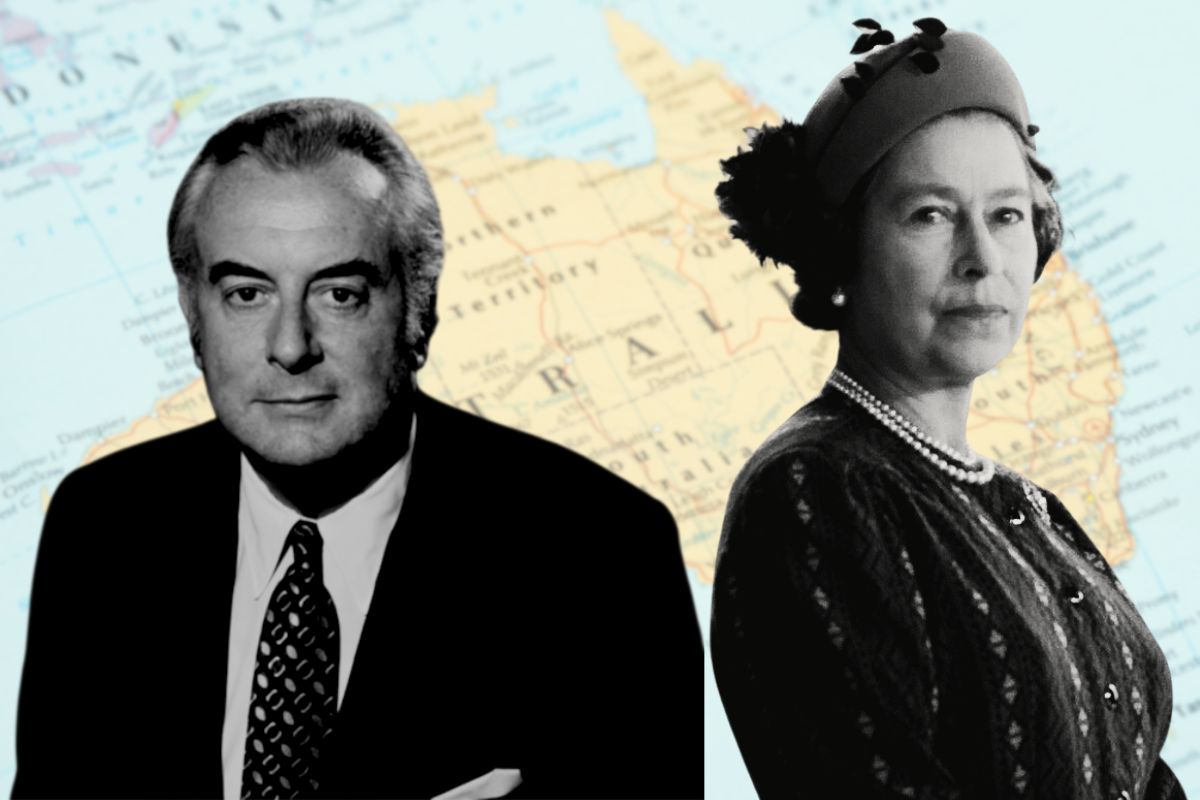Tensions are rising between Russia and Ukraine, with western politicians and journalists warning of the threat of invasion. Putin’s jingoism has highlighted the weakness of US imperialism – and the inherent instability of world relations.
Over the past few months, the world’s media has been full of talk of a new war in Europe. According to US intelligence services, Russia has moved over 100,000 troops to its border with Ukraine. It is also carrying out a joint military exercise with Belarus.
The US and NATO have held a series of talks with Russia, although none have yet resolved the situation.
What will Putin do?

There is a great deal of speculation about what Putin intends to do.
Firstly, we must warn that the reports of an ‘imminent Russian invasion’ being loudly broadcast by the western media should be taken with a large pinch of salt. These are stories made up by the CIA for the purpose of moulding public opinion.
Even less credible are the claims issued by the Zelensky government in Kyiv, including the idea that the Russians are preparing a false-flag operation to justify military action. This is a war of propaganda and should be considered accordingly; which, of course, also applies to the public statements by Putin and Sergey Lavrov, the Russian Minister of Foreign Affairs.
Western pundits have pointed to a long essay Putin wrote in July of last year, in which he described Russia and Ukraine as being “one people”. Others point to comments by Lavrov accusing NATO of being a “project aimed at taking over territories orphaned by the collapse of the Warsaw Treaty Organisation and the Soviet Union.” (our emphasis)
All of this, some argue, is supposed evidence that ‘Putin wants the empire back’.
The Russian army is clearly far superior to that of Ukraine and could invade the country, if it chose to do so, with relative ease.
The head of Ukraine’s military intelligence was quoted as saying “there are not sufficient military resources for repelling a full-scale attack by Russia if it begins without the support of Western forces.” The same article quotes Rob Lee, a former US marine, who said that Russian missiles could “wipe out a significant part of the Ukrainian military in less than an hour”.
As we saw with the US invasions of Iraq and Afghanistan, however, whilst an initial invasion may be achieved relatively swiftly, holding or absorbing a country is another matter altogether.
Putin would have to consider the fact that he would most likely have to contend with a local insurgency, even if an invasion was successful. Different polls have shown that 58% of all men or one-third of all citizens would be willing to fight against Russia if there was an invasion. The New York Times also quoted one Ukrainian commander, Oleksandr Pavlyuk, claiming that the country would “start a partisan war” if need be.
It is clear that a substantial part of the Ukrainian population would reject a Russian invasion if it were to take place. Since the 2014 Maidan protests, which led to the overthrow of the Yanukovitch government, we have seen the state promote reactionary anti-Russian Ukrainian nationalism and far-right ideology.
Support for NATO in Ukraine increased greatly in the years following the annexation of Crimea by Russia.
According to a recent opinion poll, nearly 60% of Ukranians would vote for NATO membership if there were a referendum, although the country is divided along geographical lines, with the West and Centre firmly in favour, and the East and South narrowly against (with the poll only including those parts of the Donbas which are under the control of Kyiv).
Russia would therefore be unlikely to be able to absorb Ukraine at gunpoint.
Dr Fred Kagan, a former professor of military history at the U.S. Military Academy at West Point, estimates that an occupation of Ukraine would require one counter-insurgent for every 20 inhabitants. That would mean a force of 325,000 would be necessary, just to hold Kyiv and Ukraine’s main cities in the South and East. This is not likely to be a cost that Putin would be willing to pay.
What does Putin want?

Russia has made demands of the US and NATO, including refraining from military activity in the former Eastern bloc; refraining from deploying missiles close enough to hit Russia; and the end of the eastward extension of NATO, among other things.
The western media has presented these demands as completely unreasonable, but this is pure hypocrisy. In 1989, then-US Secretary of State James Baker promised that “there would be no extension of NATO’s jurisdiction…one inch to the east.” Since then, NATO has expanded 1,000km to the east and has further promised that both Ukraine and Georgia will one day become members.
This is a military alliance which Russia perceives as a threat. Ukraine is also one of the biggest recipients of military aid from the US, receiving $2.5bn since 2014.
One can only imagine the reaction of the US government were Canada or Mexico to join a military alliance with Russia or China. Furthermore, after having signed the INF treaty (non-proliferation of intermediate-range missiles) in 1988, the US unilaterally withdrew from it in 2019.
The US complains about the sacred principle of ‘national sovereignty’ and the ‘inviolability of borders’… but it only does so when it suits its imperialist aims.
The United States is the most powerful imperialist nation on Earth, and has never hesitated in removing governments and invading countries in order to defend the interests of its own capitalist class.
It waded into wars in Iraq and Afghanistan; and it has constantly been encroaching on Russia. It has surrounded it with NATO military outposts, and has organised ‘coloured revolutions’ in countries like Georgia and Ukraine, installing regimes that are friendly to the West.
The Maidan movement was provoked by German and US imperialism. It unsettled the balance between Russia and the West in Ukraine by threatening to cut Russia off from the Ukrainian economy, which for historic reasons has strong links with Russia.
Putin, defending the interests of the Russian capitalist class, certainly wants to push back NATO. The war in Georgia in 2008 was a turning point in that respect. After several years of humiliations at the hands of western imperialists, Russia said ‘enough is enough’. There was little the US could do.
The same was the case in 2013 with Obama’s so-called “red lines’ in Syria. In that instance, the West was in the midst of a campaign to fuel an Islamist insurgency in order to overthrow Assad, who was a longstanding ally of Russia. It soon became clear, however, that the United States was not prepared to send in ground troops in order to finish the job.
The Russians therefore realised that it was safe to intervene to prop up the Assad regime and maintain Russia’s only military facility in the Mediterranean. The US could do nothing but watch Russia and Iran crush its jihadi proxies in Syria.
This was followed shortly thereafter by the annexation of Crimea in 2014, which also has important strategic and historic value for the Russian ruling class.
Washington protested and threatened Putin with consequences. Sanctions were imposed. But the fact of the matter is that eight years later, Crimea remains part of the Russian Federation, and there is very little the US can do about it.
All of this has buoyed Putin’s confidence, and has fueled his ambitions to reassert Russia as the main regional power in Eastern Europe and Central Asia. This was further enhanced after he intervened to prop up the regimes in Belarus and Kazakhstan, increasing the dependence of both countries on Russia.
In the wake of the defeat of the US in Afghanistan, Putin believes the time is once more right to reassert the interests of Russian capitalism and push back against the West. In typical gangster fashion, he uses threats on the world stage to gain leverage.
Politico claims that, in November, Putin told diplomats that a certain amount of tension would force the West to take Russia seriously. Moving large numbers of troops to the Ukrainian border is designed to achieve precisely that.
Already, there is speculation that a cyber attack which took down 70 Ukrainian government websites took place under Putin’s instruction. Russia has also carried out live-fire exercises with troops and tanks whilst the talks were taking place and there are now reports of further drills in Belarus.
Putin intends to threaten Ukraine in order to force the US and NATO to the negotiating table in order to discuss a withdrawal of NATO from Eastern Europe, and the implementation of the Minsk accords (the peace agreement signed with Ukraine on the status of its eastern regions, which would consolidate Russia’s influence inside the country).
Threats and leverage

While a full-scale occupation is out of the question, Putin’s threats are not entirely empty. It is possible that Russia could launch a ‘small war’ or surgical strike against Ukrainian military installations.
Western commentators say this could involve completely annexing the Donbas region, which is currently already controlled by pro-Russian forces; creating a land corridor to the previously annexed Crimea; or a revival of the so-called ‘New Russia’ project, which would involve an attempt to ‘cut Ukraine off from the Black Sea’.
However, it seems unlikely that Putin would wish to annex the Donbas. Leaving these regions in their current state – effectively controlled by Russia, but still a part of Ukraine – gives Putin a great deal of leverage in the country.
Equally, the ‘New Russia’ project would involve seizing the city of Odessa, a city of over one million people, 68% of whom are ethnic Ukrainians, which would involve significant costs, and the probable opening of a front of insurgency against the occupation.
It therefore seems that, if – and that is a big if – Putin were to move towards military action, the most likely route would be to create a land corridor uniting the Donbas to Crimea.
Jingoistic distraction
Putin’s other motivation is clearly to fan the flames of great power Russian nationalism in an attempt to distract people from the problems at home.
For many years, Putin was able to ride the wave of an oil boom, and his approval ratings stood at around 70%. This increased to around 85% on the back of the jingoistic mood following the annexation of Crimea. However, his popularity has again begun to slide, falling to the mid-50s in 2020 – and even lower according to certain polls.
This is due to a number of factors. The coronavirus pandemic has killed around 320,000 Russians, according to official figures.
With the declining oil prices in the wake of the 2008 crisis, the Russian economy also got into difficulties. This meant that, from 2013 to 2020, real incomes fell by 11%. On top of this, inflation currently stands at over 8%, thereby pushing the living standards of working-class people even lower.
This was the real reason for the protests that were sparked by the arrest of Navalny last year, and for the disappointing election results for Putin’s United Russia.
Part of the motivation, therefore, is likely an attempt to rekindle this reactionary nationalist spirit once again in order to cut across the developing class anger in Russian society. But whipping up nationalism by threatening war is a completely different thing to actually engaging in a long and costly war, which would have the opposite effect.
This is another reason why a full-scale military invasion is highly unlikely, as it would not be in Putin’s interest.
The weakness of the US

In response to Russia, the representatives of US imperialism have not offered much more than words.
Jen Psaki, the White House press secretary, rejected Russia’s demands, explaining that they would “not compromise the key principles on which European security is built”. Antony Blinken, US Secretary of State, declared that the US was “prepared to respond forcefully to further Russian aggression”.
Upon further investigation, however, this forceful response amounts only to “strong economic measures”, “additional defensive material to the Ukrainians” and a promise to “fortify our NATO allies on the eastern flank”.
Equally, whilst Jens Stoltenberg, the secretary general of NATO has declared that “we have troops, we have forces”, he has given no details as to what specifically could be done. Joe Biden has also pointed out that committing US forces to defend Ukraine itself is “not on the table”!
The relative weakening of US imperialism, in this case exposed by its unwillingness to commit ground troops, leads it towards retreat, which again compounds its weakness.
In a press conference on 19 January, Biden pointed out that his “guess” was that Putin “would move in”. However, he added that the response of the West would depend on “what [Russia] does. It’s one thing if it’s a minor incursion and then we [NATO] end up having a fight about what to do and not do”.
From the point of view of US imperialism, divisions with its European allies should not be expressed out in the open. However, due to the weakness of the United States, they are not able to force a united line from NATO with which to confront Russia. This was also demonstrated by French President Emmanuel Macron, who recently called for separate Europe-led talks with Russia.
The US is clearly worried about being exposed as weak in front of the world, which is why some sections of the US ruling class might incline towards a more intransigent position. But there are limits on what it can actually do. After two punishing wars in Iraq and Afghanistan, there is mass opposition to war in the United States.
What all of this reflects is the relative decline of US imperialism, which is no longer able to act as the world policeman in the same way that it did in the past. It is less able to force its allies to act as one. And space has opened up for smaller powers to manoeuvre and flex their muscles on a regional scale.
Sanctions

The US and NATO are left to rely on further sanctions. Talk has ranged from excluding Russia from the SWIFT payments system, which would hamper the ability of the country to act on the world market; to blocking the import of goods such as smartphones and car parts; or scrapping the Nord Stream 2 gas pipeline, which will transport Russian gas straight from Russia to Germany, bypassing Ukraine.
The trouble with this approach is that, if Russia really was intent on invading Ukraine, sanctions would not be enough to stop it.
First of all, while sanctions are estimated to have hit the Russian economy by between 2.5% and 3% per year, they have not achieved what they were intended to achieve. Many of these sanctions were imposed in the wake of the annexation of Crimea, but they have done nothing to force Putin to reverse the annexation.
On top of this, as the Financial Times explains, the Russian state has made efforts to reduce its reliance on the global financial system. What this means is that sanctions could actually hit the EU harder than Russia.
The EU imports more than 40% of its gas and a quarter of its oil from Russia. So barring the country from using the SWIFT payments system or putting a stop to Nord Stream 2 – especially in the context of soaring gas prices – is likely to be unpalatable for EU leaders.
This is particularly true of Germany, the main capitalist country in Europe, and the country which is most economically dependent on Russia. For this reason the German capitalists are not keen on sanctions, and Berlin has taken a position which is markedly less belligerent than that of Washington.
The head of the German navy was forced to resign for expressing this publicly, when he said that the status of Crimea would not be reversed and that what Putin wanted “and probably deserved” was “to be treated with respect”.
In an interview with Sueddeutsche Zeitung newspaper, German Chancellor Olaf Scholz said that any sanctions imposed on Russia, should it invade Ukraine, ought to be “prudent”, because “no one should harbour the illusion that there is any step that has no consequences for us”. This at a time when Washington wants its European allies to deal with Russia so that it can concentrate on China.
In addition, on the question of blocking Russia’s imports of technology, it would only take certain countries being willing to violate such a blockade for the whole enterprise to be totally ineffective. The US may try to block smartphones or anything it likes from entering the Russian market, but one can easily imagine that China would be only too willing to step in and fill the gap.
Can an agreement be found?

The question is now posed: where is this situation heading?
The main aim of the US, according to the National Security Advisor Jake Sullivan, is to “deter a Russian military invasion of further territory of Ukraine”.
US imperialism would like to maintain control over Eastern Europe. But, in order to focus its attention on China, it is pivoting away from Europe and the Middle East. This opens the opportunity for Russia to push back against what it views as a threatening advance by the West.
The US is unwilling to use troops to defend Ukraine militarily, and sanctions will not be enough to force Putin to retreat, which means that it will be forced into more concessions. There are already whispers of this.
As The Economist points out, the above quote from Sullivan leaves open the possibility of allowing Russia to annex the breakaway regions of Ukraine. There has also been talk that the US is considering a reduction of forces in Eastern Europe. This was denied by Biden, but Antony Blinken was equivocal when asked about the positioning of heavy weaponry in Poland on CNN.
Others, such as a former senior director for Russia on the National Security Council, have suggested that NATO could formally commit to preventing Ukraine from joining NATO for a set number of years.
Alongside the stick of sanctions, NATO was prepared to offer some concessions on ‘arms control’ and to make efforts for greater ‘transparency on military activity’. Similarly, a senior White House official revealed that the US was willing to “explore…reciprocal restrictions on the size and scope of [military] exercises”.
This was dismissed by Sergei Ryabkov, the Russian negotiator, who said that the talks had reached a “dead end” since these concessions did not meet the Kremlin’s main requests. In other words, the Russians can sense that there are bigger concessions to be gained.
In the recent press conference following the failure of the talks with Ryabkov, Biden laid out the latest thinking on the concessions that could be offered.
According to the US President, Russia’s two most important wishes are for Ukraine to “never be part of NATO” and that there be no “strategic weapons stationed in Ukraine”. On the second demand, he said that “we could work out something”.
On the question of whether Ukraine could join NATO, he pointed out that “in the near term” this was “not very likely”, and so this meant that “there’s room to work if he wants to do that”. He also pointed out that a summit with Putin was “a possibility”.
That Russia will not be pushed back by sanctions and the US is unwilling to commit to defending Ukraine militarily is already a victory for Russia and Putin. This was clearly shown by the meeting between Blinken and Lavrov on 21 January.
Biden is now described as being “fully prepared” to commit to talks with Putin. The Russian premier, on the other hand, seemed to be willing to let his American counterpart stew, with Lavrov saying that future talks would depend on “serious preparation”. To achieve a summit with the US President is a victory in itself for Putin.
The most likely course of events, therefore, is ongoing talks between the US and Russia, eventually ending up with the US being forced into some sort of concessions.
Small incursions from the Russian side cannot be ruled out. But a full-scale invasion of Ukraine is extremely unlikely. The US will try to keep the concessions they make behind the scenes, and paint whatever comes out of it as a victory.
What all of this shows, however, is that the US is most certainly not ‘back’. And Putin, fully aware of this fact, is taking full advantage of the situation.
The situation in Ukraine reflects the world situation. When the capitalist system is in a period of general growth, and there is enough loot to be shared amongst the different capitalist classes, the system can appear stable.
When the system is in crisis, however, each nation state attempts to assert the interests of their own ruling class all the more forcefully, leading to more friction and flare-ups – such as the one we are witnessing.
This is compounded by the crisis of US imperialism, which can no longer dictate the rules of world relations as it used to, in order to stabilise the situation. On the contrary, it is becoming a destabilising force itself.
This increasing instability is the hallmark of the period that we live in. It is the reflection of a sick system.






